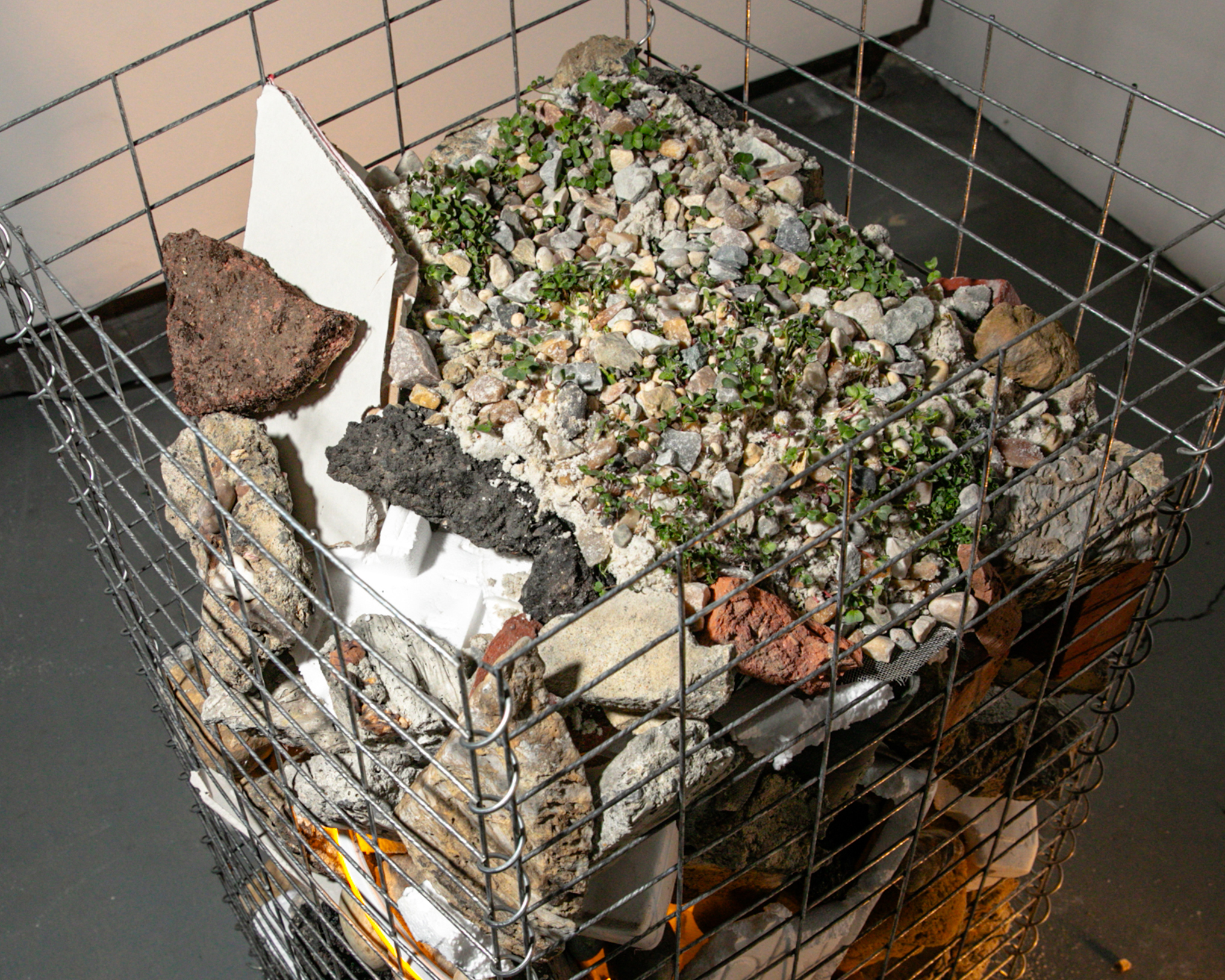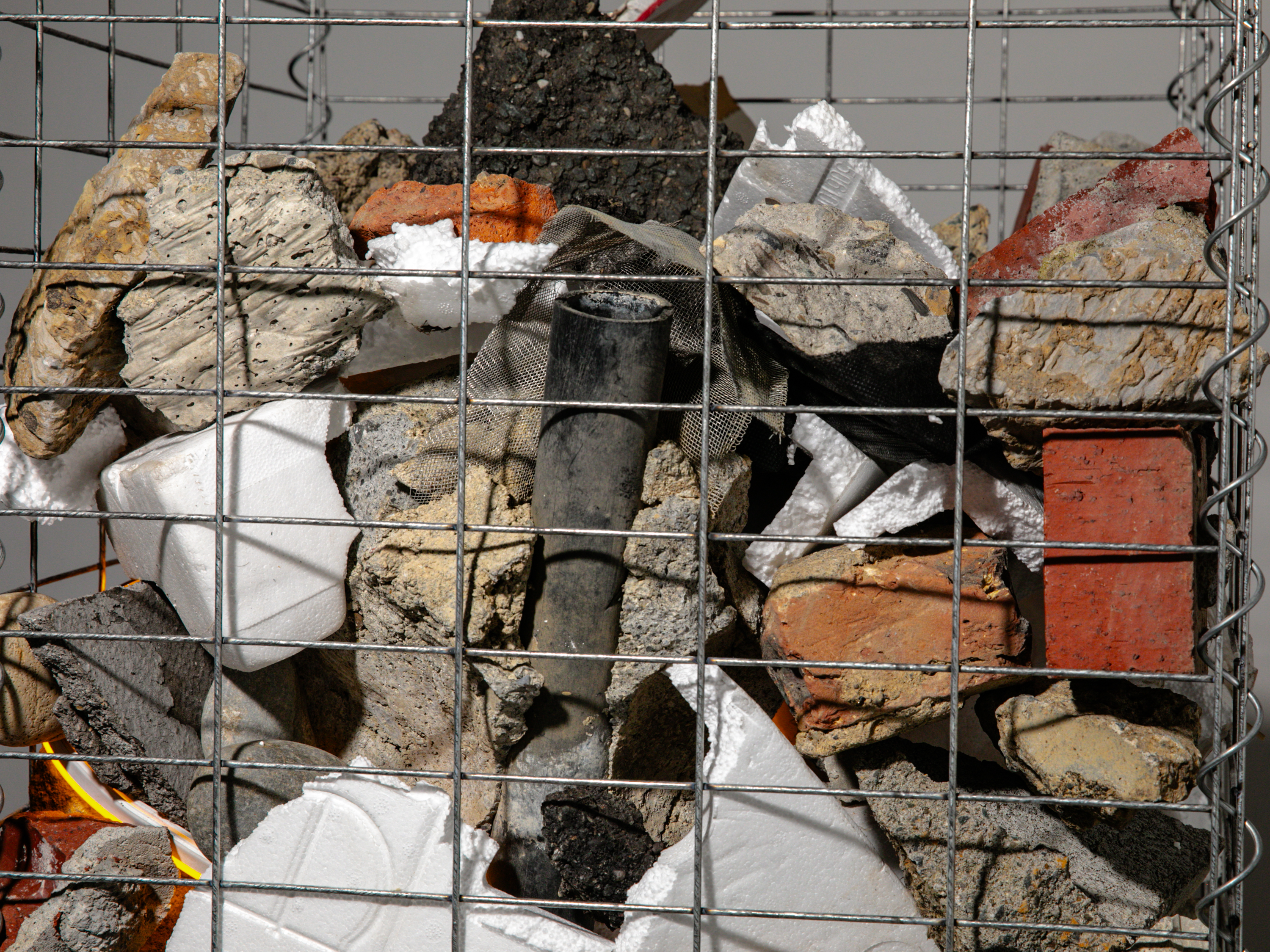

The Container
for the Thing Contained
Hans Tursack and Allie E.S. Wist
2024, gabion cage, reclaimed waste materials, LED lights, red globe radish plants, Progress #9 pea plants, sand, gravel, stones, repurposed wood, styrofoam
Electronic Arts PhD Graduate Exhibition, Rensselaer Polytechnic Institute
This sculpture is a speculative artifact in the form of a gabion—a metal cage typically filled with rocks and used in stacked formations for the construction of barriers and walls. This piece questions trends in sustainable design and climate resilient architecture which still use extractive methods. How might they, instead, coincide with adaptation in urban ruins?
This gabion is filled with a heterogeneous mix of repurposed waste materials, including detritus from the recently demolished Uncle Sam Parking Garage in downtown Troy, NY.
On the top layer, a mini plot of geological agriculture hosts edible radish and pea sprouts, which were grown directly into gravel, without chemical fertilizers or soil. So-called “gravel gardening” has limited applications, but could be a novel form of hydroponics that doesn’t require carbon-intensive fertilizers, and represents a small-scale gardening application for communities adpating in urban ruins and ruderal landscapes.




“We’ve all heard all about all the sticks and spears and swords … but we have not heard about the thing to put things in, the container for the thing contained. That is a new story. That is news.” —Ursula K. LeGuin
Gabions offer an alternative to conventional building materials. In North America, small-to-medium scale structures are typically built with balloon frame wood skeletons, foam insulation, two by fours, vinyl or wood siding, and drywall. The carbon footprint of the construction industry is currently 30% of yearly global carbon emissions.
Gabions offer a crude, low resolution addition to an emerging discourse around the recycling of building materials that are not easily processed for reuse. While gabions are currently typically filled with a homogenous mix of stone, it has potential for using waste material. Within a gabion mix, heterogeneous compounds of wood, steel, rock, concrete, foam, rubber, and plastic can be loosely combined into controlled piles. They act as a container; vessels for irregular stock. Gabions double-down on imprecision.
In Ursula K. LeGuin’s Carrier Bag Theory of Fiction, she posits that humankind’s first and most important invention wasn’t the tool, it was the carrier bag—“the first cultural device was probably a recipient… the earliest cultural inventions must have been a container to hold gathered products and some kind of carrier.” She contrasts the story of the gatherer and her carrier bag to the more fantastic story of the hero-killer, armed with weapons and tools—a portrait that dominates origin stories of human history. In climate change discourse, the hero’s story similarly occupies our imagination with promises of techno-solutions. These include massive, infrastructural interventions using brute force logics to stave off natural disasters and dissuade the movement of materials. In areas where infrastructure is needed to control flooding and erosion, gabions offer a less glamorous alternative to techno-solutions—their porosity is advantageous for draining flooded areas without allowing critical amounts of soil, land, mud and clay to shift. Gabions are a soft and low-resolution boundary that filter matter. They represent a way to build things that can and even should fall apart again, in ways which support reuse. We suggest they could function like a gathering basket for materials foraged from feral and ruderal urban sites. They can come apart and be remade again, growing and de-growing as needed, making them flexible to changing ecological conditions. They offer, perhaps, a less grandiose portrait of adaptation.
All construction techniques have a political dimension. (Swiss concrete is one example of how affluence is equated with precision construction methods.) Precision is associated with ample access to resources, arcane techniques, and technical education. But perhaps there is also a political dimension to using imprecise materials in imprecise ways to create specific thermal, insulative, structural, and aesthetic effects. Gabions are simple to construct as containers, simple to fill, and provide ample structural support in compression. While gabion-blocks are modular, they can be tied together like large bricks of waste and detritus. All of the concrete factories currently operating on the planet account for 8% of yearly carbon emissions; Gabion-logics use unprocessed waste concrete fragments from derelict buildings and infrastructure for new construction.
Of course, the gabion has an aesthetic dimension as well. Gabions are like grocery bags full of mixed ingredients. Natural materials, artificial materials, processed rocks, found rocks, dirt, plants, moss, plastic, styrofoam, and paper can all be stuffed or loosely piled into a gabion. The system’s porosity means that it has a kind of inherent sloppiness or leakage. As bricks, gabions can be stacked relatively neatly, and bound together in three-dimensional grids. The leakage they allow and their variable permeability means that they can house growth, and serve as a kind of informal planter. As plants, animals, and insects nest in the gabion-networks, they will become overgrown and their grids will become softer over time. This softening of the grid speaks to a future in which structures will become more tectonically accessible, more easily constructed. Architectural precision will become less important in scenarios where resources are scarcer.